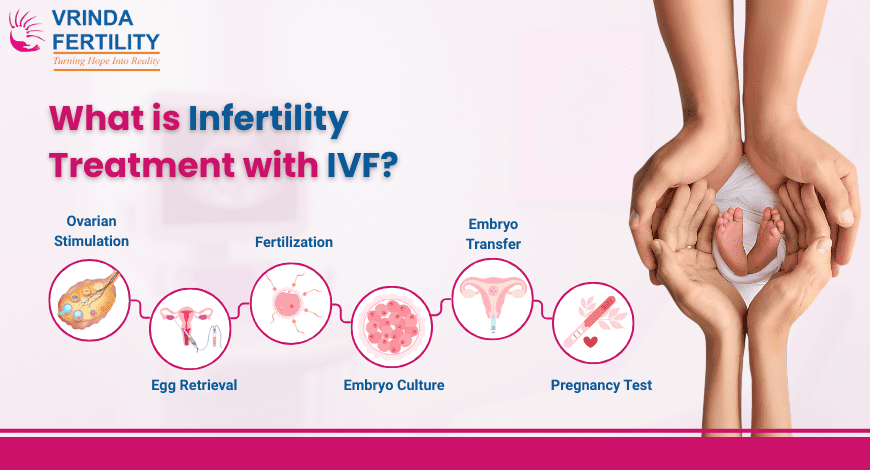Infertility is becoming a bigger worry for couples everywhere, and it can really shake up emotional well-being, friendships, and how people plan for the future. Thankfully, medical advances keep opening new doors, so many people now see hope instead of despair. One of the most popular and effective paths couples take is IVF, or In Vitro Fertilization. This guide walks you through what IVF really involves, the way the process works day by day, and why picking a top IVF center can either speed things up or slow you down on your baby journey.
Understanding Infertility
Doctors call a couple infertile when they have tried to get pregnant for a full year without using birth control and still nothing has happened. The issue can sit with either partner, and trouble may come from hormone problems, blocked fallopian tubes, low sperm count, missed ovulation, or everyday habits like smoking, drinking, or stress. Male infertility often shows up as weak sperm count, sperm that moves sluggishly, or sperm shaped the wrong way. Female infertility might appear because of PCOS, endometriosis, early menopause, or other hormones twists. Some couples get labeled “unexplained,” yet even their puzzle can be fixed at a skilled fertility clinic.
What is IVF?
IVF, short for In Vitro Fertilization, is a method doctors use to help couples become parents when getting pregnant the usual way hasn’t worked. Instead of waiting until sex or insemination delivers sperm to the egg in the body, the process moves everything into the lab. Eggs and sperm are joined outside the body to form embryos, and one or more embryos are then placed in the uterus with the hope that they will attach and begin to grow.
IVF Treatment Involves:
- Fertility medicines to encourage the ovaries to produce multiple eggs.
- A minor procedure to collect mature eggs from the ovaries.
- The embryos are watched closely for growth over several days.
- Finally, one or two healthy embryos are transferred into the womb.
Who Needs IVF Treatment?
IVF becomes a choice when other, simpler treatments have not brought a baby or when a couples situation makes natural conception very unlikely. Common reasons to recommend IVF include:
- Blocked or damaged fallopian tubes.
- Male factor infertility, such as low sperm count or sluggish movement.
- Severe endometriosis.
- Hormonal problems that cause irregular ovulation.
- Advanced maternal age, typically after age 35.
- Unexplained infertility where tests show no clear cause.
- Repeated miscarriages that have no obvious reason.
- Certain genetic conditions, when doctors do preimplantation testing.
A good fertility center will look at test results and personal history before deciding whether to move forward with IVF.
How IVF Works: Step-by-Step Process
1. Initial Consultation
The journey kicks off with an initial consultation that bundles blood work, ultrasounds, and, in some cases, partner testing to map out the best starting plan.
2. Ovarian Stimulation
During ovarian stimulation, doctors give medication in small, carefully timed doses to help the ovaries grow several mature eggs at the same time. Getting more mature eggs ready can really boost the odds that at least a few will be strong enough for fertilization, making this step a key part of the whole IVF journey.
3. Monitoring
Throughout this phase, patients return often for ultrasounds and blood tests so the team can watch each follicle as it grows. These checks tell the doctor when to collect the eggs, confirm the body is responding safely to the medication, and help dodge problems like ovarian hyperstimulation. Steady, clear monitoring boosts the chance that the IVF cycle ends with a healthy embryo ready for transfer.
4. Egg Retrieval (Oocyte Pick-Up).
When the ovaries are filled with mature eggs, doctors set up a quick outpatient procedure to gently scoop them out. The full name sounds fancy-transvaginal ultrasound-guided aspiration- but most people just call it egg pick-up. You lie on a table, a mild sedative puts you in a hazy, comfy state for about twenty to thirty minutes, and the team watches everything through an internal ultrasound screen. A slender needle slides through the vaginal wall and taps each visible follicle, suctioning the eggs one by one so they stay safe. As soon as the last egg is collected, lab staff whisk the tiny, clear bursts of fluid to a nearby incubator for fertilization. Though the procedure uses small tools and brief sedation, it marks a huge turning point in IVF and needs steady hands to keep discomfort low and avoid bleeding or infection.
5. Sperm Collection.
On the same day or the next, partners provide fresh sperm by masturbating into a sterile cup. If sperm production is very low or absent, a specialist can retrieve sperm directly from the testicle using a tiny needle under local numbing. Either way, lab workers quickly process the sample, washing away mucus, dead cells, and clumps so only the swiftest, healthiest swimmers remain. This clean, motile batch can then be used in standard IVF-or pushed into each egg with a twisty micro-needle in a technique called ICSI, based on what the doctor recommends.
6. Fertilization
In a clean lab room, doctors mix eggs and sperm in a tiny dish while keeping the light, heat, and air just right so the cells can do their thing. Sometimes they let the sperm swim in on their own, which is called regular insemination, and other times they use a thin needle to push one strong sperm straight into an egg. Which approach they pick depends on how well the sperm is moving and how many cells they have, and the embryologist makes that call. Once the cells join, the tiny embryos are watched all the time to see how fast and strong they grow.
7. Embryo Development
For the next 3 to 5 days, the embryos sit in a special incubator that acts like a mini uterus, keeping warmth and gas levels just where they need to be. Each day, lab staff count how many times the cells split, check for uneven growth, and look for any problems. By day 5 many embryos turn into blastocysts, a sweet spot that warriors the doctors look for before they can be put back inside the womb. Only the strongest ones are picked for transfer, and the extras that still look good can be frozen and saved for another try later. Choosing the best embryo is key because it gives the baby the highest chance of sticking around and growing.
8. Embryo Transfer
Doctors slide a tiny, bendy tube through the cervix and into the uterus, steering the tube with ultrasound so they dont miss. Most people feel only a light pressure, so they skip the anesthesia. Getting the embryo close to the soft uterine lining is vital; the better the spot, the better the odds it will latch on and grow. Afterward, patients usually lie still for just a few minutes, then they can walk, work, and do everything else they did before.
9. Pregnancy Test
Ten to fourteen days later, a simple blood draw checks for beta-hCG, the hormone the early placenta sends into the bloodstream. High levels mean the embryo hooked on and a pregnancy has started. If the number is shaky or low, the lab may ask for another sample a couple of days later to see if it climbs, stays the same, or drops. Waiting for this news is both thrilling and nerve-wracking; it is the first official peek at whether the IVF effort worked.
Factors Affecting IVF Success
- Age of the woman
- Quality of eggs and sperm
- Thickness of the uterine lining
- Lifestyle choices-smoking, drinking, stress
- Number of IVF attempts already done
- Conditions such as PCOS, fibroids, or endometriosis
- Skill level of the staff and lab environment
Choosing the Best IVF Centre
Picking the right fertility center calls for more than a quick internet search. The place you choose can shape both your chances of success and how supported you feel through the ups and downs. Keep these key points in mind:
- Licensing and published success rates
- Access to advanced tools such as ICSI, laser hatching, and PGT
- Years of training for doctors and embryologists
- Clear pricing and full description of each step
- What former patients say in reviews
- Availability of counseling and emotional support
An excellent IVF center combines high success rates with caring staff who personalize treatment to each couple’s needs.
Cost of IVF in India
Compared to many Western countries, IVF in India is much easier on the wallet, although prices still change from city to city and clinic to clinic.
You’ll usually pay between 1.2 lakh and 2.5 lakh for a single cycle.
Additional expenses:
- Medications
- Blood tests and scans
- ICSI or PGT (if required)
- Embryo freezing or donor services (if applicable)
Myths and Facts about IVF
| Myth | Fact | |
| IVF always results in twins | IVF can be single or multiple births, depending on embryo transfer number | |
| IVF is the last resort | It is one of many infertility treatment options | |
| IVF is only for rich people | Many fertility centers offer affordable plans | |
| IVF babies are not healthy |
|
Alternatives to IVF
Before jumping to IVF, your doctor might suggest
- Ovulation induction
- Intrauterine Insemination (IUI)
- Surgery (for fibroids or tube blockage)
- Lifestyle changes and supplements
A good fertility center will tailor the treatment based on your condition.
Lifestyle Tips During IVF Treatment
- Eat a fertility-friendly diet (rich in folic acid, iron, protein)
- Avoid caffeine, alcohol, and smoking
- Stay hydrated
- Get enough sleep and manage stress
- Gentle exercise like walking or yoga
- Take prescribed supplements
Mental Health Support for Couples
IVF can be emotionally taxing. It’s crucial to:
- Communicate openly with your partner
- Seek counseling at your fertility center
- Join IVF support groups
- Practice meditation and stress-relief techniques
Conclusion
Facing infertility can be tough, yet advances like IVF have helped many couples turn that struggle into a joyful reality. With solid facts, skilled doctors, and a caring support group, your own journey can end with the baby you dream about. Just be sure to pick a well-respected clinic-the best IVF center in your area-to get the tailored attention, better odds, and calm you deserve while you receive treatment.
Thinking about starting IVF? Book a consult soon with a fertility specialist who listens to your story and walks you gently through each step.
Fertility Center FAQs
A. Yes, IVF is safe, yet small risks such as overstimulated ovaries or twins can happen.
A. You can, though chances drop. Some choose donor eggs instead. .
A. Most feel little pain or none at all because anesthesia is often used.



